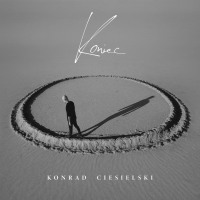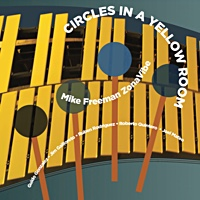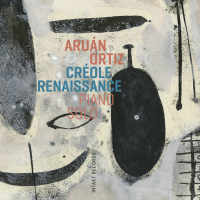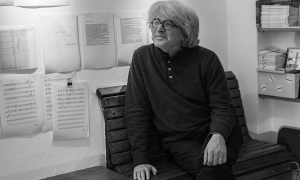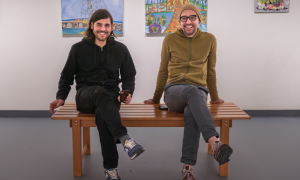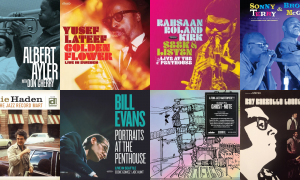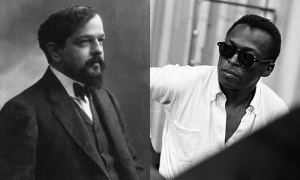Home » Jazz Articles » Interview » Anders Jormin: Touching the Heart and Spirit
Anders Jormin: Touching the Heart and Spirit
Early Days
"I do come from a musical family in the sense that my father was a professional jazz musician before I was born," says Jormin, "although by the time I was born he had quit the professional musician life to get a more ordinary job in order to support the family. So I learned the basic rules of standard jazz language in early childhood, and so did my brother Christian, who is five years younger than me. We played a lot of jazz music at home when I was young, so I had a good foundation. Then I did more traditional training at music school, classical music first on piano and later on the double-bass; I finally ended up studying at the conservatory and then moving to Gotenberg, where I studied music at the university level for a number of years."But while Jormin was deeply involved with the classical tradition, his own aesthetic was already being formed through exposure not only to jazz, but to the Swedish folk tradition. And at an early age Jormin was already looking at ways to combine these three diverse influences into a more personal approach."I don't think it was a very conscious goal in the beginning," Jormin explains, "but it has been very natural for me. As a Scandinavian musician studying music, I studied classical music and I studied jazz music, which I already knew a lot about from my upbringing with my father. But we also have a folk music tradition that is more and more alive in Sweden. It was, of course, very strong a hundred years ago, fifty years ago, but then almost completely disappeared, and now it's coming back. There were good players who inspired me as a young musician, for example a well-known musician in Sweden named Jon Johansson, who really dug deep into the folk music tradition while still being definitely a jazz player So that and classical music always interested me. I always had those three things going on in my head and played them in different ways at different times. I take all my inspirations and influences into some kind of melting pot which is inside my heart, and what comes out is, I hope, my personality."
When asked who he would cite as influences from a jazz perspective, Jormin names few artists."As a very young player I listened a lot to Miles and Coltrane," Jormin says, "and, of course, I'm not the only one. But I still say to students when they ask a question like this, 'John Coltrane is my house god,' for the energy and strength and power in his music. As a young musician/bassist I was quite fascinated by both Charlie Haden and Gary Peacock—the early Gary Peacock, the Albert Ayler free music playing Gary Peacock, although they were quite different as musicians. Of the two I must say that Charlie Haden was a bigger influence for me in the beginning. Not for the way he played his bass, as I realize that they way I play bass has very little to do with him, but for the strength and power in the music he created. I was also very lucky to play with Joe Henderson quite early on in my career, and that was a big inspiration, and I still find him as an underestimated genius on tenor saxophone."
Emerging on the Swedish Scene
Emerging onto the Swedish scene in the late '70s and early '80s, Jormin had the opportunity for exposure to a wide variety of players in Gotenberg, a city where the emphasis seemed more on the cultivation of creative music rather than event-based music."There was quite a happening music scene in the late '70s and early '80s," explains Jormin, "and I was fortunate to move to Gotenberg, the second largest city in Sweden, which had quite a living musical situation with lots of different music and musicians happening. At that time musicians were moving from different parts of Sweden to either Stockholm or Gotenberg. But looking back you can definitely see that, while Stockholm tended to be a more traditional jazz centre—big band music, entertainment music, etc.—Gotenberg became more concert music, the improvised music being played in concerts rather than behind a star, sitting in a big band. So the scenes were different and, looking back, I am happy that I decided to go to Gotenberg rather than Stockholm as a young player because for me that scene was much more interesting and challenging."The local jazz club," continues Jormin, "which is a very good and quite famous one called Nefertiti, still did the kind of concerts where an American star—Dexter Gordon or Horace Parlan for example—would travel up here and play with local rhythm sections. So I was fortunate to do that kind of gig for a couple of years; had I been a couple of years younger I would have missed that whole way of doing jazz music -the star coming and playing with the local guys which was, of course, a very interesting education for me. That, combined with studying in school, was very, very good experience for me."
First Projects and Bobo Stenson
By the mid-'80s Jormin had already established himself as a player of note on the Swedish scene, recording his first album as a leader, Nordic Lights in '84. It was on this album that Jormin first teamed up with pianist Bobo Stenson, already a local legend through his classic recordings with saxophonist Jan Garbarek for ECM."The first situation where we played together," explains Jormin, "was when I formed my first serious band, which was called Nordic Lights, and also became my first album under my own name. We played my arrangements of Scandinavian classical music. It was all by the major composers of Scandinavia -Danes, Norwegians and Swedes mostly. I rearranged them for a quartet with saxophone, piano, bass and drums and I asked Bobo to play in the band. He came to Gotenberg and we started working together and I guess we found each other quite immediately on a musical level, although he was already very experienced and I was quite a young guy, but it worked very well. Later on he got me playing with the band Rene Rama, where I replaced Palle Danielsson; that was quite a well-known jazz quartet."I really admire Bobo's ability to improvise in the truest meaning," continues Jormin."I can honestly say that, having played a lot of concerts with him and, for short periods, basically the same material evening after evening, it is never the same. From the first note it may be completely different. That was a big inspiration for me and I still admire it, because in the whole world of jazz players, I have actually come to realize that few are true improvisers, and Bobo is one of them. His music is not built upon patterns or anything like that -pre-worked arrangements. And he is never interested in trying to redo the success of last night. If you suddenly come up with something interesting onstage it's very tempting to do it again. He is not very interested in that, and that's also a good example of a really strong improviser. Additionally, he has classical studies in his background, and on the records we have done together there's always a couple of classical pieces, most of them from my pen or suggestions/arrangements from me, but he is always happy when I come up with them."
Alone
Jormin's second album, Eight Pieces also featured Stenson, but in a larger ensemble and, at the same time, Jormin began to work as part of Stenson's own trio. For his third release, '91's Alone, Jormin would make a move that is risky even for an established bassist, by recording an album of solo double-bass music. But the album, which combined in-the-moment improvisations with lyrical interpretations of material by artists including one of his favourite composers, the Cuban Silvio Rodriguez, established Jormin's reputation as a bassist of note."The album actually gained me enormous positive credit for many years," Jormin says."That record suddenly gained me a name as one of the major bassists in Scandinavia, basically overnight. I received many different awards and prizes, so sometimes it's worth taking the risk."Charles Lloyd and Tomasz Stanko
His association with Stenson would lead to his first recording for ECM, Charles Lloyd's '92 recording, Notes from Big Sur."That was my first experience with Manfred Eicher," Jormin says, "playing with Charles Lloyd. I think Charles must have asked Bobo who he should use, and Bobo recommended me. I know he was very happy with the band during those years. It meant a lot to him. We had some wonderful years and tours, some great experiences for me, I'm very happy for that period."While Lloyd would supply almost all the compositions for the four recordings Jormin made with him, he trusted his group's instincts implicitly."His compositions," explains Jormin, "were quite often just sketches, a little unfinished or a little vague, probably on purpose. He would come with directions, because we did rehearse—not very much, but we did rehearse. But his directions were very typical Charles Lloyd—I can give you an example from my first rehearsal, which I'll never forget. He looked at me and said, 'Give me some St. Petersburg.' That was what he wanted to hear from me, and I was of course, quite unsure. What kind of music is that? And another, 'Take me to India.' Most of his instructions were so emotional and coloured by his imagination and his way of thinking musically, so what they actually meant, both for me and for Bobo, was, 'Go ahead guys, and play what you think fits the simple sketch I've done.' Bobo and I would also do some work with his compositions—we added a chord here, added a bar there, and suddenly the sketches worked very well. Charles never asked, 'What did you do with this composition, suddenly it sounds good,' but it was ultimately a good collective process."
At the same time as they were working with Lloyd's quartet, Jormin and Stenson also played in Polish trumpeter Tomasz Stanko's quartet, recording two albums, Matka Joanna and the classic Leosia. The approach to the music, while sharing certain characteristics with Lloyd, was still quite different."In a way you could say they were sketches," Jormin says, "but at the same time, quite carefully composed, meaning that if you sat down and played what Tomasz wrote, they were very beautiful pieces. But then, when performing, he was not so interested in playing exactly what he wrote, rather he was quite happy with whatever we came up with; he was definitely interested in free improvisation. What it meant was that he composed very beautiful compositions all the time, and we played them the way we wanted, and then the improvisations were free. They could have been excellently played over the form—the chords and harmonic structure of the compositions, because they were great, Tomasz Stanko is a great composer—but he leaves the performance of his music to the moment and he's very happy with that."
Commissions
While his association with Stanko and Lloyd continued, along with more trio work with Stenson, Jormin continued to pursue his own projects for the Dragon label. Often-times stemming from commissions, Jormin sees that as a huge differentiator between support for the arts in Europe and the United States."In Europe, in general, there's a bigger support for the arts," says Jormin."How do we do it? We have high taxes, that's where the money comes from, compared to the United States, where they don't have such high taxes and don't support the arts in the same way. I think it has been especially important in Scandinavia, because our countries are big but with very few people, and should it be at all economically possible to have art spread across the country there must be generous support for it. Norway is, I would say, the best example of a country that supports its arts—they do it very well, and they are very proud of their jazz musicians, their improvising musicians, while Sweden is more into supporting classical music in general, so my kind of music gets only a little of the total amount. But a lot is needed and it's important."Jord
'95's Jord, meaning Earth or Soil, stemmed from a commission for the International Society for Contemporary Music, and featured an unusual quintet of double-bass, vibraphone, keyboards, trumpet and percussion."The ISCM is a very fine gathering of new music lovers from around the world," Jormin explains, "they have some kind of congress once a year, and it was in Stockholm that year. The host country always gives out a couple of commissions of new music, and I was one of the composers chosen. So it was a commission performed during the ISCM congress. And I did choose, and always choose, musicians I find I have great respect for or musicians that I am very curious about for different reasons."I learned, through the years," Jormin continues, "not to choose the instrumentation, meaning I choose the people first, and then see what kind of band I have—is it four harps and a clarinet? Hmm, that's very difficult, so maybe then I think twice, but in general I choose artists that I really appreciate. Rather than looking for a trumpet player, I look for a certain kind of expressiveness, and I had worked with Per Jorgensen, the Norwegian trumpet player who was on that record, through Jon Balke, a Norwegian colleague of mine, and I always admired his presence on stage. He's an excellent performer and inspirational, both for the audience and for his fellow musicians in the playing moment. He's really focused and present; that goes for all the players on Jord, I like them all for different reasons. I like the vibraphone; it's cold but played in the right way, still very warm, and in combination with the electric keyboards it's very rich."
Jord also featured Jorgensen and percussionist Lisbeth Diers singing, and the human voice has a quality that Jormin has ultimately returned to time and again."Per is well-known, in my part of the world, for his fantastic singing," Jormin says, "while Lisbeth, who I made sing duet with him, had never sung before. So I encouraged her, and sometimes I used my own voice as well. This can be seen as an expression of my deep interest in singing and also my own small efforts to use my voice, not always to great success, but I am working on it—not taking singing lessons, but mentally—so it may be that I'll use my voice more in the future. I actually recorded a vocal piece for Xeiyi, my first solo record on ECM, but Manfred took it away, I guess that tells you something about the level of my singing."
Silvae
In '98 Jormin recorded another commission, with an intriguing premise." Silvae is Latin for Forests, and was commissioned by Swedish Radio. Sometimes commissions come with certain conditions, and for this one the condition was that it should be people who had not worked together before. So I put together a sextet with [trumpeter] Arve Henriksen and [guitarist] Marc Ducret, for example, two people who didn't know each other. In fact nobody knew each other besides me and my brother [drummer] Christian."Marc Ducret was an interesting choice," continues Jormin."My choice was not to write music that would fit him, but instead to challenge him. And to challenge Marc Ducret you have to do more structured things, because he is a master of the non-structured, the tough side of music. So I would challenge him this way, and challenge other musicians in other ways; the music ultimately sounded familiar or traditional, but hopefully there's something special with every tune."
The commission, as performed, was split equally between relatively free improvisations and the more structured pieces which, of course, also had plenty of space for exploration."There is always lots of improvisation in my music," explains Jormin, "because that's what I like, that's where the personality of the players comes through more easily, but in this case we did lots of free improvising with small sketches, or suggestions from me. We were actually talking about releasing Silvae as a double album, but that's where economy comes in—there wasn't the money for it, and since it was a commission I decided together with the producers to use the composed part for the record. We talked about releasing the other material later, but it has never happened; it's also very good. It's somewhere on my shelves, but it will probably never be released."
ECM and Xeiyi
After years contributing to other artists' albums on ECM, Silvae was, in fact, originally intended to be Jormin's first release on the label under his own name." Silvae was supposed to be an ECM release, but it turned out that the commissioner of that piece, Swedish radio—the government radio—already had a deal with Dragon that I didn't know about, so when ECM found this out they decided they didn't want to be accused of releasing music that actually belonged to another smaller label. Instead we started discussing what to do next, because Manfred was eager for me to record an album for ECM, my having been then playing on maybe nine or ten releases. I had the idea to follow-up Alone, to do it again, to basically do it ten years later and see where I was."The result was Xeiyi, meaning "to write," or "to compose your thoughts." Recording a second album of solo bass represented its own challenges."I think Xeiyi was partly a way of challenging myself," explains Jormin, "and also maybe checking myself, seeing if I could do the concept of Alone once again, but even deeper, even better, from my own personal point of view. I think I can hear myself having become a much better bassist. The things I do on Xeiyi are, in a way, much more advanced, much more complex, but the expression and simplicity, at the same time, is the same and that's what I wanted. You can say it's a risk to try and do it again ten years later, because it would be natural to say, 'Now he does it a second time, it's boring' but I got very positive reviews for it as well. I think it is a development of what I did on Alone, to see what I could do with my supposedly clumsy instrument; how melodic, how easy, how musical can I be on the bass?"
Advanced Techniques and Another Influence
Jormin has developed a number of unusual techniques for the double-bass, many of them influenced by instruments other than his own."Well, I have spent a few hours on the bass, and developed a couple of playing techniques that are either loaned from other instruments, like the classical guitar, or maybe from Jaco Pastorius on the electric bass. He put bass and melody together somehow, he made the bass a musical instrument. He could play very groovy and very technically advanced, but also very melodically. He was also a great composer. The few things he had time to do were really good, so he was a big influence on me."So I invented a few things myself," continues Jormin, "that are already being used by quite a few bassists in Sweden, Norway and Denmark. And they always say that they stole them from me. They're nothing dramatic, just a few playing techniques that slowly spread; once you see somebody do it, it's like, "Oh, this is how he does that!' It's just things people didn't think of.
Trust
Xeiyi is differentiated from Alone by more than simply ten years of distance. Breaking up the solo pieces is a series of chamber pieces for brass ensemble that lends the album an even more unique complexion."I recorded a whole solo bass album with Manfred," Jormin says, "and then later, when it was to be released, Manfred called me up and said, 'Anders, I hear some brass music here.' Then I said, "Oh do you, I don't,' but he still wanted me to consider composing small sketches for brass in order to mix up the album, because that's what he heard, having listened a lot to it. And while I actually said no at first, a whole summer came and went and then I called him up and said, 'OK Manfred, I did some compositions, do you want me to record them?' And so I recorded them without his presence, with four guys from the symphony orchestra here in town, four very, very good players, and Manfred loved it, and scattered the pieces between my bass pieces."Eicher allows Jormin a quite uncharacteristic degree of freedom with his own records."I think it comes from the fact," explains Jormin, "that Manfred said to me, 'I trust you Anders, it's almost as if you don't need me.' I think he has some kind of respect for my artistic potential and he also knows there is a certain direction in my music that he has found, and that's what he's looking for most of the time. When there is trust then he doesn't say very much. It's the same way we record with Bobo, he doesn't say very much because there is already a solid concept.
"I have felt a lot of trust from Manfred," continues Jormin."In other cases, when he finds his schedule makes it impossible for him to come to a recording session as planned, he would just cancel the recording; that's something I have experienced in other situations. But for me he just says, 'Anders, just go on, I trust your music.' I think he knows that when I want to record I have a very good and strong idea behind it, and he's happy with that. I am really happy to feel that I have Manfred's full confidence and I'm very fortunate."
On the other hand, the one place where Eicher continues to exert his influence is with the sequencing of the compositions."On both my own albums for ECM," Jormin says, "Manfred has had ideas. On Xeiyi he changed my suggestion of order, doing it in a totally new sequence, although on the new album, it has a certain order because it's a big composition. So there he agreed with me, but he could have had opinions and then most probably I would have accepted them, because I think he is very good at putting the tunes in the right order. I have seen that many times, on Bobo's recordings as well, it's always Manfred's order of tunes. I find that his sequencing of tunes is sometimes quite daring, he is never interested in putting some kind of hit tune as the first track. The first track might be very obscure; he trusts and requests from the listener to experience the record as a piece of art in itself."
In winds, in light
Jormin's new disk, In winds, in light, is an ambitious song-cycle that resulted from a commission to create new sacred music."When I got the commission to write the piece," says Jormin, "it was not actually said that it should be a song cycle, it was just said that it should be a piece of new sacred music, to give new life to church music somehow; but I immediately felt that lyrics had to be a part of it. And I think, if I can remember, my choice fell very quickly with [singer] Lena Willemark, with whom I had collaborated on a few occasions."The commissioner actually had one suggestion," Jormin continues."They happened to know and really like [pianist] Marilyn Crispell, and they suggested to me that she should play the church organ. So that was the only suggestion, but it turned out that Marilyn had never done it and she is always very concerned with doing a great job, so I came up with the idea of letting Marilyn play the piano, and I decided to use Karin Nelson, an experienced and highly appreciated organist. I found it quite inspiring to mix piano and organ; it's not done very much. So Lena was an early choice, and then for percussion I found Raymond Strid inside my head quite quickly. To me it's quite a logical combination, because somehow I could hear the sound of this music inside of me.
"It's a cycle with a certain order," concludes Jormin, "and there are improvised spots, but they are also quite structured, meaning I have written who is playing and in what style—I wrote, for example, a small fugue for the organist to improvise over. So it is quite a composed cycle, meaning that even though the improvisations are different, they are at the same time quite similar. The record gives a good picture of a live performance, but you lack, of course, the presence of seeing and hearing Lena sing, which is a fantastic experience actually."
Some of the most defining moments on the album come from Willemark's vocals. With Jormin's compositions, and lyrics that expound on the larger concept of spirituality in the firmament, Willemark proves herself to be an incredibly profound vocalist, sometimes caressing the lyrics, other times screaming them in almost existential pain.
"Those sounds and coughs," Jormin explains, "they are a part of her improvising technique, so I didn't have to give her direction, but those high things that she's screaming, extremely loudly, they're something that I both wrote and asked her to do. It's a traditional Swedish singing-in-the-forests technique; when you want the cows to come back, you do this. It's also used to send messages from one valley to another one, it's called kulning, and Lena is of a true folk music family, an upbringing from a remote part of Sweden, so when she does this it's for real. And it is so strong and penetrating that the microphones almost have to be turned off, or they get broken. You can't measure the decibel of that sound; we had to redo those parts of the composition a couple of times, having Lena walk yet another ten meters away from the microphone and yet another ten, in order to be able to record it; it's extremely loud and it's definitely not a concert singing technique, but it's part of her natural music and of course I wanted to use that."
While Eicher was originally meant to be there for the recording session, a broken leg prevented his traveling to Sweden and so, once again, Jormin was left with full artistic license. The album was originally meant to come from a live performance of the cycle but, unfortunately, events conspired against that happening."The idea," Jormin says, "was to release, if not the very first performance, then the second performance. It was recorded, but church organs are very sensitive to humidity and temperature, and on that day the organ's tuning was very high, A was at 447, so the piano had to be tuned extremely high, which meant that on the last third of the concert the piano was out of tune. The recording of the cycle was a very good one, but we couldn't use it because the piano was so out of tune, so we had to re-record it almost a year later."
Touring and Longevity
Jormin has done some shows in support of the release of In winds, in light, and hopes that the album will reach a broad audience."I'm hoping for some recognition and, of course, good reviews," says Jormin, "and then we'll see what can be done in terms of touring. Of course we need special rooms; finding a room that has or can provide both a good piano and a good organ, that's a challenge. Another problem is that churches in Europe, in general, are a little too conservative to have concerts played, using the organ in this semi-secular kind of way, meaning that in many interesting rooms they do not want to have that kind of concert, while it is more liberal in Scandinavia; we can use churches as concert halls."With the more project-oriented releases that Jormin has done, does he ever wish he had a more long-term, ongoing band? "I think the truth is," Jormin explains, "that my weak side is the organizing, gig-fixing side of things, meaning that many of my projects are the result of a commission. We do the commission concert, maybe one or two tours more, and then I simply don't have the time, energy and patience to sit down and organize myself. In Scandinavia, the system of concert agents doesn't really work. It's probably because it's so small, meaning there's not a lot of money for a concert agent unless we go down into Germany and south of that. No agents down in Europe have been that interested in selling my projects, because it's a little too difficult music or uses too many unknown Scandinavians, or whatever the reasons that they have had, and I haven't had the energy to go on myself. So after a project has been quite successful, a year passes and I go onto a new project and then that falls apart. I would really like to have a band, but being a composer, touring bassist and part time teacher, there is no time for me to hang on the telephone and do the business side."
Still, his ongoing relationship with Bobo Stenson provides Jormin with a longer-term project, although drummer Jon Christensen, who held the drum chair for many years, left a couple of years back."Since Jon Christensen left the band for different reasons, we've had Paul Motian as the drummer for the trio. We've done a couple of tours but, for a variety of personal reasons, the trio hasn't worked very much for the last two years, since Paul became our drummer. Now the trio is back at work but Paul had a serious heart attack last year and has said that he'll never leave New York again. I don't know if he'll be able to persist with that. But we now have a new drummer, a very good young Swedish drummer. I actually wanted to record our new album with the new drummer, when we realized that Paul would no longer be touring with us, but Manfred felt that it should be Paul since that was the original idea for the recording, even though the recording had been postponed several times. The album was done in April of this year, and will probably be out around Christmas. That's a guess—it usually takes about a year from the recording to release for an ECM record, it's a very long time, sometimes longer. But Manfred is really happy with this record, he actually calls now and then just to say how much he loves it, so I have a feeling that the release date will be sped up a bit."
Heart and Spirit
While Jormin has enjoyed a strong reputation in Europe, and especially Scandinavia, for many years, now that his work is reaching a larger audience through ECM's international distribution, hopefully he'll make larger inroads elsewhere, in particular North America. While he has clearly forged some new directions for the double-bass, the reality is that he is far more than "just" a bassist; he is a consummate artist with a broad artistic vision that comfortably and seamlessly melds jazz, classical and Swedish folk music concerns into a deeply personal style. Jormin's albums may vary widely in terms of their instrumentation and concept, but constant is the drive to make music that challenges the mind while, at the same time, touching the heart and spirit.Tags
PREVIOUS / NEXT
Support All About Jazz
 All About Jazz has been a pillar of jazz since 1995, championing it as an art form and, more importantly, supporting the musicians who make it. Our enduring commitment has made "AAJ" one of the most culturally important websites of its kind, read by hundreds of thousands of fans, musicians and industry figures every month.
All About Jazz has been a pillar of jazz since 1995, championing it as an art form and, more importantly, supporting the musicians who make it. Our enduring commitment has made "AAJ" one of the most culturally important websites of its kind, read by hundreds of thousands of fans, musicians and industry figures every month.













